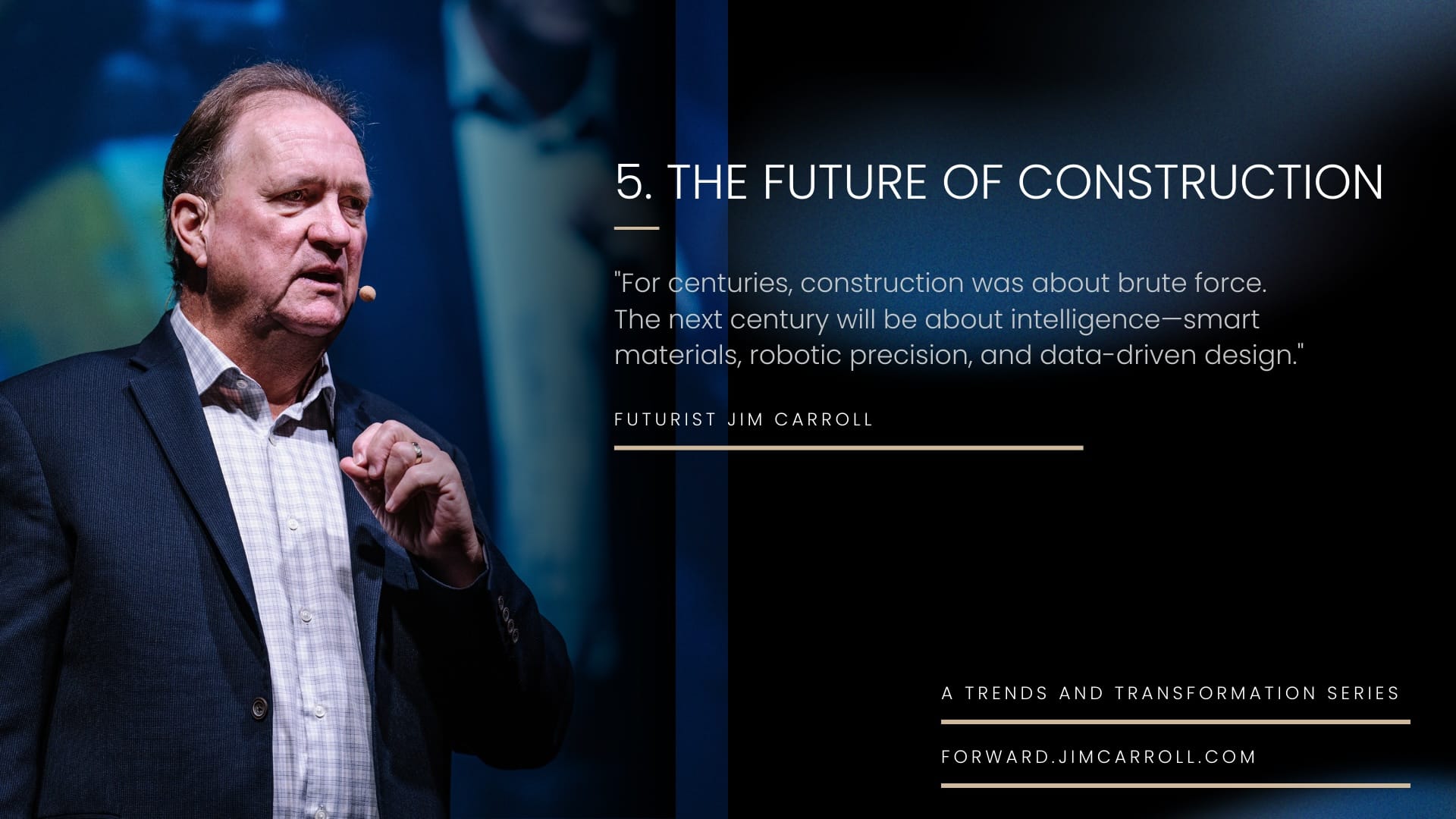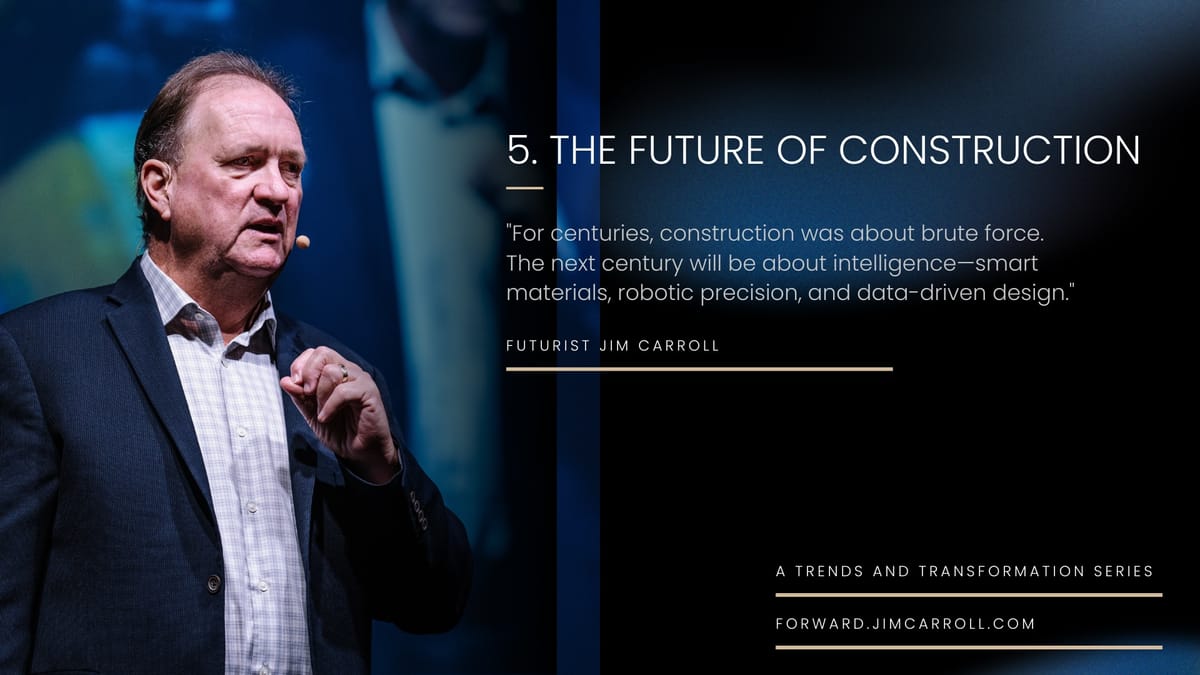"For centuries, construction was about brute force. The next century will be about intelligence—smart materials, robotic precision, and data-driven design." - Futurist Jim Carroll

In 2025, the headwinds are severe, and the path forward seems shrouded in fog. We’re living through one of the most volatile and unpredictable periods in recent memory. With that being the case, I am writing this new series, The Way Forward: A Trends and Transformation Series, taking a look at the trends redefining industries, and actionable strategies organizations must pursue to align with these realities. The entire series will be found at forward.jimcarroll.com
For centuries, the core principles of building have remained relatively unchanged.
Today, however, a powerful convergence of digital technology, advanced materials, and new methodologies is transforming every aspect of how we design, build, and manage the world's buildings & infrastructure. Like most other industries, construction is moving from a project-based, physically-intensive model to a data-driven, technologically-advanced ecosystem.
Let's dig in.
The landscape: 10 trends redefining construction
Looking back at the keynotes I've done and what I've written about trends in this sector, certain key things stand out. Obviously, the future of construction is arriving faster than you think. These are the powerful currents reshaping the built environment.
- Digital twin technology & virtualization. The industry is moving from 2D blueprints to dynamic, 4D digital twins—virtual replicas of physical assets used from design through to lifelong operational management.
- AI-driven design and project management. Artificial intelligence is becoming the new engine of construction intelligence, used to generate optimized designs, predict project timelines, and identify potential safety risks.
- Robotics & automation on the job site. Robots are moving out of the factory and onto the construction site, with autonomous vehicles for earthmoving, brick-laying robots, and drones for site surveys, addressing labor shortages and improving safety.
- Off-site & modular construction. The process of building is shifting from the construction site to the factory floor, improving quality, reducing waste, and shortening project timelines.
- Accelerated materials science. The very materials we build with are being reinvented, with innovations like self-healing concrete, transparent solar-generating glass, and carbon-negative building materials.
- The rise of intelligent infrastructure. Our buildings, roads, and bridges are becoming smart and connected, with integrated IoT sensors creating "living" structures that can monitor their own health and manage energy in real-time.
- Sustainability & the circular economy. Green building is moving from a niche market to a core business imperative, with a growing focus on "design for deconstruction" to reuse materials and eliminate waste.
- The advanced skills gap. As construction becomes a technology-driven industry, there is a massive new demand for professionals with skills in data science, robotics, digital modeling, and systems integration.
- The transformation of infrastructure investment. Massive global investment is shifting toward 21st-century infrastructure, including the build-out of a new distributed energy grid, 5G communication networks, and EV charging infrastructure.
- Hyper-connectivity & location intelligence. The job site is becoming a fully connected, data-rich environment, with real-time data from drones, sensors, and wearables providing unprecedented visibility and control.
Put them all together, and nothing in the world of construction will look much like it does today.
A Deeper Dive: The Most Significant Forces Reshaping Construction
While all ten trends are critical, a few stand out for their immediate and profound impact. Their convergence is creating a powerful, self-perpetuating flywheel of innovation.
AI & Data Analytics: From Project Management to Predictive Maintenance
Artificial Intelligence (AI) is rapidly transitioning from a futuristic concept to a practical, value-adding tool for construction SMEs.
AI-driven project management platforms can automate complex scheduling and resource allocation, predict potential delays, and provide real-time progress tracking for better decision-making. In the preconstruction phase, AI tools enhance the accuracy of estimating, providing realistic forecasts for labor, material, and equipment costs, thereby reducing the risk of budget overruns. I had a construction event in Chicago where one company displayed a stunning piece of estimating software which shaves significant time off of the estimation process. On-site, AI-powered systems, often utilizing drones and computer vision, can monitor for safety hazards and ensure compliance with protocols.
For construction companies, the primary value proposition of AI is its ability to optimize resource use, reduce costly errors, and provide the data-driven insights needed to improve profitability and compete more effectively. Sure, there's a lot of hype right now, but there is also an awful lot of very powerful stuff coming together.
Robotics & Automation: Augmenting the Workforce for Precision and Safety
Robotics and automation are emerging as a crucial response to two of the construction industry's most pressing challenges: the chronic labor shortage and the persistent need for higher quality and precision.
On-site robotics can automate tasks that are physically strenuous, repetitive, and require a high degree of accuracy, such as drilling, welding, or site layout. A key development making this technology more accessible to SMEs is the rise of aftermarket automation systems.
Companies like Built Robotics have engineered solutions such as the Exosystem,., a package that can be retrofitted onto existing heavy equipment from major manufacturers like Caterpillar and John Deere. This transforms a standard excavator or dozer into a fully autonomous robot, allowing companies to gain the benefits of automation without the prohibitive capital cost of purchasing an entirely new, specialized fleet.
Digital Twins & Immersive Reality: Enhancing Collaboration and Eliminating Rework
Digital twin technology is one of the most revolutionary concepts reshaping the construction landscape. A digital twin is a dynamic, virtual replica of a physical asset—such as a building—that is continuously updated with real-world data from sensors and scans.
This creates a powerful tool for the entire project lifecycle, from initial design through long-term facility management. For SMEs, the most immediate benefits lie in enhanced collaboration and risk reduction. By creating an immersive, high-fidelity 3D model of a project site, firms can enable remote teams, clients, and stakeholders to conduct detailed virtual site visits. This drastically reduces the need for physical travel, saving significant time and money while also lowering the project's carbon footprint.
Modular & Offsite Construction: Building Faster, Smarter, and More Sustainably
Modular construction represents a paradigm shift from traditional, site-based building to a manufacturing-centric approach where building components are produced in a controlled factory environment and then transported to the site for assembly. We used to do most building and construction assembly on site - increasingly, we'll do more of it in a factory-like setting, off-site.
This methodology directly confronts many of the construction industry's chronic weaknesses. By moving up to 90% of the construction activity off-site, it can accelerate project timelines by as much as 50% and reduce on-site manpower requirements by up to 40%, according to some estimates. This addresses both the demand for faster project delivery and the persistent shortage of skilled labor.
While the sector includes large developers, the modular ecosystem is rich with opportunities for SMEs, who can thrive by specializing in the manufacturing of specific components, such as bathroom pods or facade panels.
The Digital Divide: Barriers to a Modern Construction Industry
Of course, progress is great, but it often happens unevenly. Big construction behemoths are already actively using and exploring these opportunities; many medium-sized and smaller ones remain shut out.
Why is that? No doubt the construction sector is an economic behemoth built upon a vast foundation of small and medium-sized enterprises. This structure, however, creates a fundamental tension: the very firms that constitute the industry's operational core are the most constrained in their ability to innovate.
- Financial constraints: The most significant inhibitor for SMEs is funding. The high upfront cost of digital tools is the principal reason given for non-adoption. This is compounded by a deep-seated fear of technological obsolescence; 50% of business leaders express concern about investing in a technology that could quickly be outdated.
- Skills and human capital: A critical and rapidly worsening barrier is the pervasive skills shortage. Globally, 53% of construction firms are concerned about a lack of workers with suitable skills. The lack of in-house technical expertise directly impedes the ability to implement and derive value from new digital systems.
- Data and digital infrastructure: A staggering 65% of firms in Spain and Portugal worry about having accurate, structured data from which to make business decisions. This data fragmentation leads to immense inefficiency, with the average employee spending 13 hours per week simply searching for information.
- Organizational and cultural resistance: The construction industry is notoriously traditional and risk-averse, with a deeply ingrained cultural inertia that resists change. This is reinforced by a lack of client and stakeholder demand for digital tools, creating a self-perpetuating cycle of low expectations and slow progress.
Beating the Odds: Case Studies in Construction Innovation
Despite these formidable barriers, a growing number of SMEs are successfully navigating the path to modernization, providing a practical blueprint for others to follow. I dug into a few articles reporting on how organizations are moving forward:
- AI-Powered Project Management (Mid-Sized Firm): A mid-sized construction firm was caught in a cycle of inefficiency, facing chronic scheduling challenges and frequent, unexpected equipment breakdowns. By adopting a targeted AI software solution focused on scheduling and predictive maintenance, the firm significantly reduced equipment downtime, lowered costs, and gained control over project timelines and budgets.
- Layout Robotics (Rugged Robotics): For a large-area equipment layout project, Brogoitti Construction deployed the Rugged Robotics solution and slashed its projected timeline from eight weeks to under two weeks—a 75% time saving. On another project, Suffolk Construction used the same technology to cut layout time by 60% while simultaneously reducing costly rework by 75%.
- Digital Twins (Swinerton Construction): Faced with severe restrictions on job site access during the COVID-19 lockdown, Swinerton deployed Matterport's digital twin platform. The use of the immersive 3D model directly eliminated four weeks of potential project delays, reduced client travel time by 100%, and, by enabling early virtual reviews, saved the client thousands of dollars in prevented rework.
- Modular Construction (Elements Europe): An analysis of the Camp Hill residential project in the UK revealed a dramatic reduction in its logistical footprint. Compared to a traditional project, the modular approach required 3,700 fewer deliveries, a 56% reduction in vehicle movements. The project also demonstrated an approximate 35% reduction in embodied carbon.
- The Circular Economy (KLAW Industries): This small business, supported by the EPA's SBIR program, developed an innovative process for turning waste glass into a high-performance material that can replace traditional cement. The resulting concrete is not only stronger and lower in cost, but also boasts 97% lower carbon emissions compared to the cement it replaces.
10 Actionable Strategies for Construction Innovators
The future of construction will be defined by those who are bold enough to act. So what can they do? Start thinking about the small steps that matter!
- Build a roadmap: The future is a journey that should be mapped out. At least get going!
- Focus on a culture of innovation: The human element is paramount. Change must be driven from the top with active and visible leadership. Invest in upskilling your workforce by partnering with community colleges and industry associations like the NAHB. Empower your field crews by choosing "field-ready" technologies with intuitive mobile interfaces.
- Find money! Overcome the funding barrier with a proactive approach. Create a dedicated "innovation budget" for pilot projects. Appoint a "funding scout" to navigate the complex landscape of public grants and tax credits like the SR&ED program in Canada or SBIR grants in the U.S. Explore tech-specific financing from institutions like the Business Development Bank of Canada (BDC).
- Think tech! Make digital tools the foundation of your entire process. This means moving beyond paper blueprints to fully embrace Building Information Modeling (BIM) and digital twins for every project.
- Invest in learning and experimenting with off-site and modular construction: Shift as much of the building process as possible from the unpredictable environment of the job site to the controlled environment of a factory. This is one of the most powerful strategies for improving quality, speed, and predictability.
- Learn to collaborate more: The complexity of modern construction requires deep collaboration. Forge strategic partnerships with technology startups, academic institutions like Germany's Fraunhofer Building Innovation Alliance, and materials scientists to gain access to cutting-edge innovations.
- Explore the circular economy: Make green building a core competitive advantage, not just a compliance issue. Actively explore and pilot the use of new, sustainable materials and adopt "design for deconstruction" principles to create long-term value.
- Upskill your workforce: The skills gap is one of the biggest threats to the industry. Partner with community colleges and trade unions to develop training programs for the new roles of the digital era. Invest heavily in upskilling and reskilling your existing workforce.
The construction industry is at a historic inflection point.
Technology, automation, and intelligence are not just incremental improvements; they are the building blocks of a fundamentally new way of doing things. For an industry long defined by its resistance to change, the coming decade will be a period of profound challenge and unprecedented opportunity. The leaders who thrive will be those who move beyond traditional methods and embrace a new identity as technology-driven innovators.
The future of construction will not be built with the blueprints of the past.
It will be assembled with digital twins, intelligent machines, and sustainable materials, guided by a new generation of leaders who are not afraid to build a bolder, faster, and smarter world.
Futurist Jim Carroll covers the construction industry in his blog at https://jimcarroll.com/category/construction/

